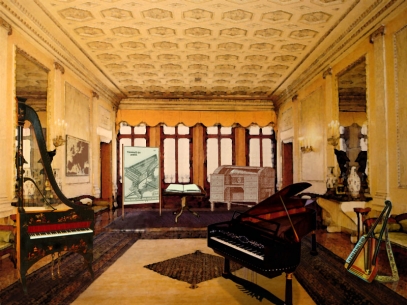Introduction - Curios
All the instruments here have a few things in common: their fascinating novelty but also their failure because of some unsolved (an sometimes appearing unsolvable) problems in fulfilling dreams centuries-old: Dreams of a keyboard instrument with bowed strings, a portable piano, or the idea to apply a keyboard to all the other musical instruments not having one. In times when a firm belief prevailed of being able to solve every problem with new technical achievements, certain limits faced up again and again which could only be surpassed seemingly or not at all. All those inventions - and some of these were invented not only once but again and again - had no lasting success.
This of course makes one wonder "Why?"; why could keyed harps, lutes, harmonicas or the Geigenwerk not succeed? Was it technical failure, unreliability, insufficient interest of musicians, composers, the musical public, high costs? And these questions need to be mirrored to those inventions which were successful in the end: Why had Cristofori's „Gravecembalo col piano e forte“ a different fate than the „Dulce melos“ reported by Arnaut von Zwolle c.1440, both being keyboard instruments with hammers striking strings. But the „Dulce melos“ was forgotten so thoroughly that only a few decades later nobody left any information about it, but Cristofori's pianoforte was a success story like none other, wasn't it, (was it)?
Many incidents contribute to success as well as failure; some of either appear almost foreseeable, as if the lucky, or unlucky inventors could have known better before. Sometimes even the initial ideas appear absurd and make one wonder why someone took all the efforts, time, money, passion to end in predictable failure. And at times only a tiny bit, some detail, seemed missing to success at last: maybe a little more interest of the listeners, a less flawed construction, or at times a little less secrecy of the inventor.
All these "failures" gathered here are waiting for "their" Cristofori to come for centuries. And all these chapters could end with the announcement "To be continued (?)"
© Greifenberger Institut für Musikinstrumentenkunde | info@greifenberger-institut.de




